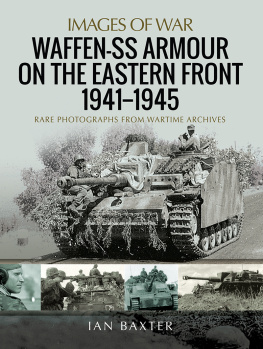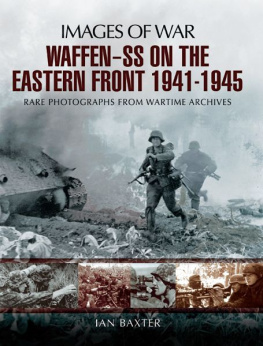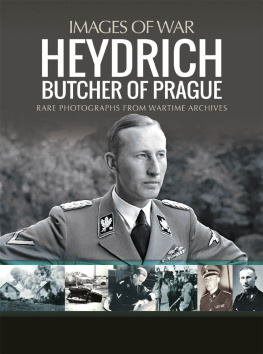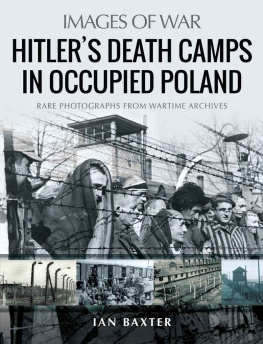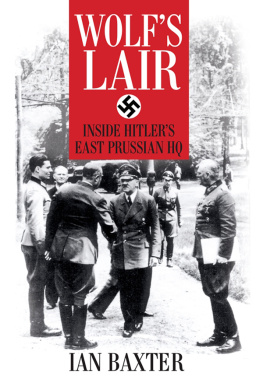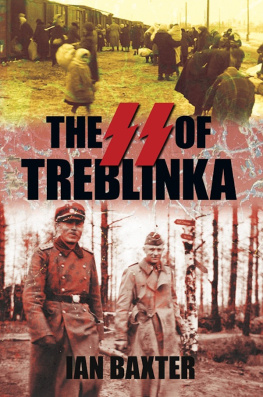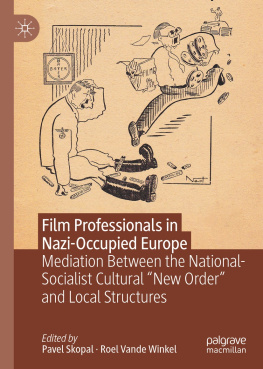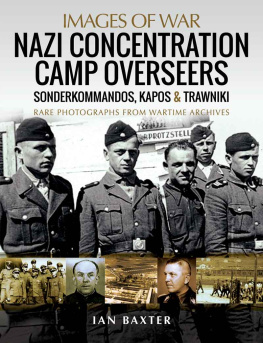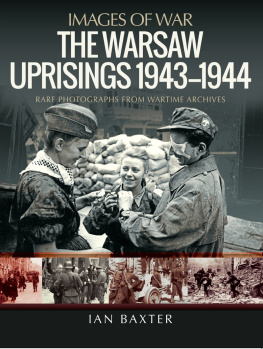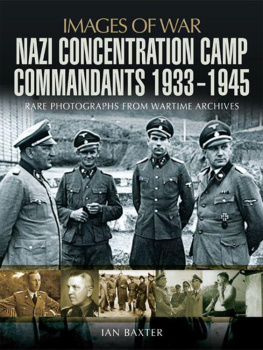Ian Baxter - The Ghettos of Nazi-Occupied Poland
Here you can read online Ian Baxter - The Ghettos of Nazi-Occupied Poland full text of the book (entire story) in english for free. Download pdf and epub, get meaning, cover and reviews about this ebook. year: 2020, publisher: Pen and Sword Military, genre: Science fiction. Description of the work, (preface) as well as reviews are available. Best literature library LitArk.com created for fans of good reading and offers a wide selection of genres:
Romance novel
Science fiction
Adventure
Detective
Science
History
Home and family
Prose
Art
Politics
Computer
Non-fiction
Religion
Business
Children
Humor
Choose a favorite category and find really read worthwhile books. Enjoy immersion in the world of imagination, feel the emotions of the characters or learn something new for yourself, make an fascinating discovery.
- Book:The Ghettos of Nazi-Occupied Poland
- Author:
- Publisher:Pen and Sword Military
- Genre:
- Year:2020
- Rating:4 / 5
- Favourites:Add to favourites
- Your mark:
- 80
- 1
- 2
- 3
- 4
- 5
The Ghettos of Nazi-Occupied Poland: summary, description and annotation
We offer to read an annotation, description, summary or preface (depends on what the author of the book "The Ghettos of Nazi-Occupied Poland" wrote himself). If you haven't found the necessary information about the book — write in the comments, we will try to find it.
The Ghettos of Nazi-Occupied Poland — read online for free the complete book (whole text) full work
Below is the text of the book, divided by pages. System saving the place of the last page read, allows you to conveniently read the book "The Ghettos of Nazi-Occupied Poland" online for free, without having to search again every time where you left off. Put a bookmark, and you can go to the page where you finished reading at any time.
Font size:
Interval:
Bookmark:

IMAGES OF WAR
RARE PHOTOGRAPHS FROM WARTIME ARCHIVES
Ian Baxter

First published in Great Britain in 2020 by
PEN & SWORD MILITARY
An imprint of
Pen & Sword Books Ltd
47 Church Street
Barnsley
South Yorkshire
S70 2AS
Copyright Ian Baxter, 2020
ISBN 978-1-52676-180-4
eISBN 978-1-52676-181-1
Mobi ISBN 978-1-5267-618-2-8
The right of Ian Baxter to be identified as author of this work has been asserted by him in accordance with the Copyright, Designs and Patents Act 1988.
A CIP catalogue record for this book is available from the British Library.
All rights reserved. No part of this book may be reproduced or transmitted in any form or by any means, electronic or mechanical including photocopying, recording or by any information storage and retrieval system, without permission from the Publisher in writing.
Pen & Sword Books Limited incorporates the imprints of Atlas, Archaeology, Aviation, Discovery, Family History, Fiction, History, Maritime, Military, Military Classics, Politics, Select, Transport, True Crime, Air World, Frontline Publishing, Leo Cooper, Remember When, Seaforth Publishing, The Praetorian Press, Wharncliffe Local History, Wharncliffe Transport, Wharncliffe True Crime and White Owl.
For a complete list of Pen & Sword titles please contact PEN & SWORD BOOKS LIMITED
47 Church Street, Barnsley, South Yorkshire S70 2AS, England
E-mail:
Website: www.pen-and-sword.co.uk
About the Author
I an Baxter is a military historian who specialises in German twentieth-century military history. He has written more than fifty books including Poland The Eighteen Day Victory March , Panzers In North Africa , The Ardennes Offensive , The Western Campaign , The 12th SS Panzer-Division Hitlerjugend , The Waffen-SS on the Western Front , The Waffen-SS on the Eastern Front , The Red Army at Stalingrad , Elite German Forces of World War II , Armoured Warfare , German Tanks of War , Blitzkrieg , Panzer-Divisions at War , Hitlers Panzers , German Armoured Vehicles of World War Two , Last Two Years of the Waffen-SS at War , German Soldier Uniforms and Insignia , German Guns of the Third Reich , Defeat to Retreat: The Last Years of the German Army At War 194345 , Operation Bagration the Destruction of Army Group Centre , German Guns of the Third Reich , Rommel and the Afrika Korps , U-Boat War , and most recently The Sixth Army and the Road to Stalingrad . He has written over a hundred articles including Last days of Hitler, Wolfs Lair, The Story of the V1 and V2 Rocket Programme, Secret Aircraft of World War Two, Rommel at Tobruk, Hitlers War With his Generals, Secret British Plans to Assassinate Hitler, The SS at Arnhem, Hitlerjugend, Battle of Caen 1944, Gebirgsjager at War, Panzer Crews, Hitlerjugend Guerrillas, Last Battles in the East, The Battle of Berlin, and many more. He has also reviewed numerous military studies for publication, supplied thousands of photographs and important documents to various publishers and film production companies worldwide, and lectures to various schools, colleges and universities throughout the United Kingdom and the Republic of Ireland.
I t was my intention to write no more about the treatment of the Jews by the Nazis: I believed there were already enough books on the subject. It was my 12-year-old son Felix who suggested I write about the ghettos. I looked into the idea and found he was right: there was room for another book, especially one with pictures and captions. The Holocaust has placed an indelible mark upon the twentieth century and on our consciousness. As I researched I became increasingly interested in how the Nazi government planned to control the Jewish population, forcing them to live in special restricted sections of towns.
The Nazi leadership in Berlin saw the ghettos as a provisional measure to control and segregate Jews while they deliberated on their fate. Their decision was to transport them to various labour or death camps around Europe where almost all of them would die.
There were around a thousand ghettos in Europe during the early period of thewar, but my focus in the book was mainly on the Polish ghettos of Warsaw, d, and Krakw. For these I was able to find sufficient material including many images, thebulk of which I have obtained from the United States Holocaust Memorial Museum (USHMM).
The photographs in this book were mostly taken by German soldiers with a passion for photography who were stationed in the surrounding towns and cities and given access to the ghettos. For instance, Willy Georg, radio operator: while stationed in Warsaw he supplemented his income by taking pictures of his comrades, and during the summer of 1941 he was issued a pass by one of his officers and given instructions to enter the ghetto and bring back photos of what he saw.
Sergeant Heinrich Joest was also stationed in Warsaw in 1941. With his Rolleiflex camera he was given permission to enter the ghetto and in just one day he shot 140 images of life there, some of which are revealed in this book.
There is also a collection of unique colour slides taken by Walter Genewein. Genewein was head of the d ghetto economy serving under Hans Biebow. He was a keen amateur photographer, and with his camera took chilling photographs of life in the d ghetto including disturbing photos of Jews being prepared for transportation to labour or death camps.
I hope that this book will become a valuable addition to Holocaust studies, and we all hope that we never have to encounter such an abhorrent regime as that of the Nazis ever again.
W ith Adolf Hitlers swift victory over Poland in September 1939 the Germans acquired territory with a population of 20 million, of whom 17 million were Polish and 675,000 were German. His plan had always been to clear the Poles and Jews from these territories and replace them with German settlers. What followed was a period of unrestrained terror in Poland, particularly in the incorporated territories. The areas not incorporated contained a population of some 11 million. These included the provinces of Lublin and parts of Warsaw and Krakw. Initially they were collectively termed the General Government of the Occupied Polish Areas and in 1940 were renamed the General Government. This large area was used as the dumping ground for all those deemed undesirable and enemies of the state. It was here that the first Poles and Jews were deported in their thousands.
During the first cold months of 1940 the General Government forced thousands of homeless and penniless people into an already overpopulated area. In their place came thousands of ethnic Germans, all of whom had to be provided with suitable housing. The scale of the relocation was enormous and chaotic.
By the end of January the immense problems of simultaneously attempting to relocate Poles, Jews and ethnic Germans had become such an administrative nightmare that it was agreed that all Jews should be forced to live in ghettos. The first ghetto was established on 8 October 1939 at Piotrkow Trybunalski, just days after the defeat of Poland. Two months later another had been erected in Tuliszkow. The Nazis saw that the ghettos would not only relieve the burden of the resettlement programme, but it was also a way of temporarily getting rid of the Jewish problem. The Nazis hated and feared the Jews, and believed that Eastern Jews in particular were carriers of disease; to isolate them in ghettos was deemed immediately practicable. Plans were put into practice across the General Government to create an extensive network of ghettos, while the rest of the country outside these isolated areas continued to endure harsh Nazi policies.
Font size:
Interval:
Bookmark:
Similar books «The Ghettos of Nazi-Occupied Poland»
Look at similar books to The Ghettos of Nazi-Occupied Poland. We have selected literature similar in name and meaning in the hope of providing readers with more options to find new, interesting, not yet read works.
Discussion, reviews of the book The Ghettos of Nazi-Occupied Poland and just readers' own opinions. Leave your comments, write what you think about the work, its meaning or the main characters. Specify what exactly you liked and what you didn't like, and why you think so.


